 Biographies: People and Places is the theme of this week’s book review group from the Children’s Literature and Reading Special Interest Group of IRA. The picture book biography has become an especially popular genre with teachers and young readers in recent years. Not only are the lives of famous people being written about but authors have done a wonderful job ferreting for information about the lives of lesser known folks whose contributions to today’s living was significant. Illustrators have added their beautiful artwork and various artistic styles to make these biographies a treat for the visual aspects of stories. For older readers, authors are doing research into primary sources, documents, and archival photography to bring those real facts from history to the printed page for young readers. From STEM to Visual Arts to Music in the Schools to Native Cultures and more, biographies offer a portal to yesteryear of long ago or simply yesterday.
Biographies: People and Places is the theme of this week’s book review group from the Children’s Literature and Reading Special Interest Group of IRA. The picture book biography has become an especially popular genre with teachers and young readers in recent years. Not only are the lives of famous people being written about but authors have done a wonderful job ferreting for information about the lives of lesser known folks whose contributions to today’s living was significant. Illustrators have added their beautiful artwork and various artistic styles to make these biographies a treat for the visual aspects of stories. For older readers, authors are doing research into primary sources, documents, and archival photography to bring those real facts from history to the printed page for young readers. From STEM to Visual Arts to Music in the Schools to Native Cultures and more, biographies offer a portal to yesteryear of long ago or simply yesterday.
ReadWriteThink offers a large number of ideas for biography lesson plans, including Biography Research, Using Role Play to Study Authors’ Lives, Celebrating Women Brave and Strong, Book Buddy Biographies, or create a Bio Cube with students.
Teachers and students will enjoy dropping in on Bio.com and click, “On This Day” to find daily birthdays.
GRADES K-2
Barry, Holly M. (2013). Helen Keller's best friend Belle. Illus. by Jennifer Thermes. Park Ridge, IL: Albert Whitman & Company.
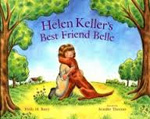 Young readers are likely to be familiar with the basic story of Helen Keller, but if they aren’t, this partial picture book biography tells her story as it relates to her beloved dog, Belle. The book’s endpapers are filled with the fingerspelling signs for each letter of the alphabet while the book describes Helen's early years and the changes that occurred once Anne Sullivan came to work with her. It's a softened version of her struggles to communicate but the added twist concerning her fondness for dogs adds to its child appeal. Readers will enjoy the sections about Belle, especially how Helen tried to teach Belle how to fingerspell and greeted her dog once she returned from Boston from a trip where she learned to speak, and wish to know more about the bond between Helen and Belle. The last pages provide more information about Helen and the other dogs in her life, which will foster curiosity in their stories too. The illustrations depict Belle as lanky, loyal, and affectionate, a patient companion for Helen Keller during particularly dark days.
Young readers are likely to be familiar with the basic story of Helen Keller, but if they aren’t, this partial picture book biography tells her story as it relates to her beloved dog, Belle. The book’s endpapers are filled with the fingerspelling signs for each letter of the alphabet while the book describes Helen's early years and the changes that occurred once Anne Sullivan came to work with her. It's a softened version of her struggles to communicate but the added twist concerning her fondness for dogs adds to its child appeal. Readers will enjoy the sections about Belle, especially how Helen tried to teach Belle how to fingerspell and greeted her dog once she returned from Boston from a trip where she learned to speak, and wish to know more about the bond between Helen and Belle. The last pages provide more information about Helen and the other dogs in her life, which will foster curiosity in their stories too. The illustrations depict Belle as lanky, loyal, and affectionate, a patient companion for Helen Keller during particularly dark days.
- Barbara A. Ward, Washington State University Pullman
Bober, Natalie. (2013). Papa is a poet; a story about Robert Frost. Illus. by Rebecca Gibbon. Christy Ottaviano Books. New York: Henry Holt Co.
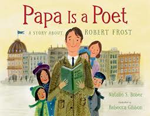 Lesley Frost, eldest daughter of poet Robert Frost, narrates in first person the story of the life of her father, poet Robert Frost. Taken from Lesley’s childhood journals, Lesley recalls life growing up on their poultry farm in New Hampshire. Though often times their cupboards were sparsely filled with food she remembers each day being filled with life especially directed by her father’s drive to live each day to the fullest. As he taught his children to read and write, and then rewrite, he was also teaching them to enjoy all of nature’s offerings surrounding them in their beautiful Derry Farm setting. After a two-year stint in England where Frost wanted to concentrate on writing, the family comes back to America to find that finally his work is being published. Watercolor illustrations, acrylic ink, and colored pencils provide the folk art style that depicts the Frost family appropriately. An author’s note with more details on the life of Robert Frost, photos, quotes and poems complete the book. Teachers might enjoy sharing this short video of Robert Frost on the day of President John F. Kennedy’s inauguration.
Lesley Frost, eldest daughter of poet Robert Frost, narrates in first person the story of the life of her father, poet Robert Frost. Taken from Lesley’s childhood journals, Lesley recalls life growing up on their poultry farm in New Hampshire. Though often times their cupboards were sparsely filled with food she remembers each day being filled with life especially directed by her father’s drive to live each day to the fullest. As he taught his children to read and write, and then rewrite, he was also teaching them to enjoy all of nature’s offerings surrounding them in their beautiful Derry Farm setting. After a two-year stint in England where Frost wanted to concentrate on writing, the family comes back to America to find that finally his work is being published. Watercolor illustrations, acrylic ink, and colored pencils provide the folk art style that depicts the Frost family appropriately. An author’s note with more details on the life of Robert Frost, photos, quotes and poems complete the book. Teachers might enjoy sharing this short video of Robert Frost on the day of President John F. Kennedy’s inauguration.
Karen Hildebrand, Ohio Library and Reading Consultant
Burleigh, Robert. (2013). Look up!: Henrietta Leavitt, pioneering woman astronomer. Illus. by Raul Colon. New York: Simon and Schuster Books for Young Readers.
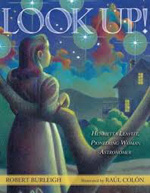 Teachers who are looking for female scientists, especially as pioneers of astronomy, and a connection to STEM concepts will find this book an addition to women’s history in science. Henrietta Leavitt was born in 1868 and later graduated from Oberlin and Radcliffe at a time when women scientists were a rare breed. As a result, she was given rather menial tasks at her Harvard Observatory job. Women were allowed to measure and calculate data and observe but it was doing these tasks where Henrietta’s discoveries became new scientific territory. She observed and found a way to measure the brightness of stars. This lead her to the hypothesis that the universe was much larger than previously believed. Working against the bias and skepticism of fellow male astronomers, Henrietta continued her dedicated research and work in astronomy using the Harvard Observatory telescope where she eventually made a name for herself as a pioneer in the field of astronomy. Colon’s watercolor and pen and ink illustrations of the night skies and throughout the book complement the text beautifully. Back matter and author notes complete the book. Check out the article, “Unpacking a Standard” (Booklist, June 1 & 15, 2013, p.80) for standards-based lesson ideas using this book and others. Learn more about Henrietta Leavitt at the American Association of Variable Star Observer’s website.
Teachers who are looking for female scientists, especially as pioneers of astronomy, and a connection to STEM concepts will find this book an addition to women’s history in science. Henrietta Leavitt was born in 1868 and later graduated from Oberlin and Radcliffe at a time when women scientists were a rare breed. As a result, she was given rather menial tasks at her Harvard Observatory job. Women were allowed to measure and calculate data and observe but it was doing these tasks where Henrietta’s discoveries became new scientific territory. She observed and found a way to measure the brightness of stars. This lead her to the hypothesis that the universe was much larger than previously believed. Working against the bias and skepticism of fellow male astronomers, Henrietta continued her dedicated research and work in astronomy using the Harvard Observatory telescope where she eventually made a name for herself as a pioneer in the field of astronomy. Colon’s watercolor and pen and ink illustrations of the night skies and throughout the book complement the text beautifully. Back matter and author notes complete the book. Check out the article, “Unpacking a Standard” (Booklist, June 1 & 15, 2013, p.80) for standards-based lesson ideas using this book and others. Learn more about Henrietta Leavitt at the American Association of Variable Star Observer’s website.
- Karen Hildebrand, Ohio Library and Reading Consultant
Cummins, Julie. (2013). Flying solo; how Ruth Elder soared into America’s heart. Illus. by Malene R. Laugesen. New York: Roaring Brook Press.
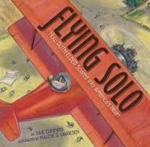 Though most people immediately think of Amelia Earhart as America’s flying aviatrix, her contemporary was Ruth Elder. Ruth was a beauty queen with a dazzling smile and spunky personality. In 1927 after reading about the flight of Charles Lindbergh she decided she wanted to be the first woman to cross the Atlantic Ocean. On the day of the flight, winking and playing to the press, she declared she always wanted a Parisian gown, so why not fly there and buy one? Unfortunately, her plane The American Girl, malfunctioned and dove into the Atlantic Ocean. A dramatic rescue saved Ruth’s life. Following the crash Ruth’s fame spread and she entered a cross-country airplane race nicknamed the Powder Puff Derby. Illustrations of pastels offer aerial views and other details of this adventurous and plucky young woman as she paved the way for future generations of female pilots, predicting the day when women would become fighter pilots. Pair this book with Daredevil; the life of Betty Skelton reviewed later in this column for more stories on early American women pilots.
Though most people immediately think of Amelia Earhart as America’s flying aviatrix, her contemporary was Ruth Elder. Ruth was a beauty queen with a dazzling smile and spunky personality. In 1927 after reading about the flight of Charles Lindbergh she decided she wanted to be the first woman to cross the Atlantic Ocean. On the day of the flight, winking and playing to the press, she declared she always wanted a Parisian gown, so why not fly there and buy one? Unfortunately, her plane The American Girl, malfunctioned and dove into the Atlantic Ocean. A dramatic rescue saved Ruth’s life. Following the crash Ruth’s fame spread and she entered a cross-country airplane race nicknamed the Powder Puff Derby. Illustrations of pastels offer aerial views and other details of this adventurous and plucky young woman as she paved the way for future generations of female pilots, predicting the day when women would become fighter pilots. Pair this book with Daredevil; the life of Betty Skelton reviewed later in this column for more stories on early American women pilots.
- Karen Hildebrand, Ohio Library and Reading Consultant
Kolpin, Molly. (2013). Barbara Park. Illus. by Michael Byers. Mankato, MN: Capstone Press.
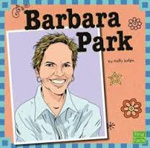 Fans of the irrepressible Junie B. Jones series will want to read this short biography of author Barbara Park to learn more about its creator. They may find it interesting that Park intended to be a teacher and even took education courses. Instead, she became interested in telling stories and learned to write humorous books for children. Young readers may smile in identification as they reading how she likes to write while wearing her pajamas. Although it might have been useful to include more information about the inspiration for her books as well as tips for budding writers, this brief biography will please Park or Junie B. Jones fans.
Fans of the irrepressible Junie B. Jones series will want to read this short biography of author Barbara Park to learn more about its creator. They may find it interesting that Park intended to be a teacher and even took education courses. Instead, she became interested in telling stories and learned to write humorous books for children. Young readers may smile in identification as they reading how she likes to write while wearing her pajamas. Although it might have been useful to include more information about the inspiration for her books as well as tips for budding writers, this brief biography will please Park or Junie B. Jones fans.
- Barbara A. Ward, Washington State University Pullman
Markel, Michelle (2013). Brave girl: Clara and the shirtwaist makers’ strike of 1909. Illus. by Melissa Sweet. New York, NY: HarperCollins/Balzer + Bray.
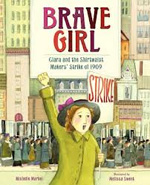 When young Jewish immigrant, Clara Lemlich, arrives in New York with her family, she hopes for better things in life. She wants to read, learn English, and study. Instead, she is met with a rude surprise: her father is unable to find work, and Clara finds a job in a factory that made garments for women. It's hard work, from dawn to dusk. There are 300 girls working in a sunless and stuffy factory with only two filthy toilets, one sink, and three towels. Clara attends night school, survives on only a few hours of sleep, but she is determined to change the working conditions for women. She organizes walk-outs and puts her life in danger. Clara is arrested and imprisoned 17 times, and once the police beat her so badly that she had six broken ribs. Undaunted, Clara calls for a general strike, and for the first time, thousands of young women, some just 12 years old, stream out of the factories and march on the streets of New York. This worker for social justice was convinced that wrongs could be set right in America, and that warriors can wear skirts and blouses. Today factory workers work decent hours and only five days a week. Clara is a giant even though she was only five feet tall.
When young Jewish immigrant, Clara Lemlich, arrives in New York with her family, she hopes for better things in life. She wants to read, learn English, and study. Instead, she is met with a rude surprise: her father is unable to find work, and Clara finds a job in a factory that made garments for women. It's hard work, from dawn to dusk. There are 300 girls working in a sunless and stuffy factory with only two filthy toilets, one sink, and three towels. Clara attends night school, survives on only a few hours of sleep, but she is determined to change the working conditions for women. She organizes walk-outs and puts her life in danger. Clara is arrested and imprisoned 17 times, and once the police beat her so badly that she had six broken ribs. Undaunted, Clara calls for a general strike, and for the first time, thousands of young women, some just 12 years old, stream out of the factories and march on the streets of New York. This worker for social justice was convinced that wrongs could be set right in America, and that warriors can wear skirts and blouses. Today factory workers work decent hours and only five days a week. Clara is a giant even though she was only five feet tall.
- Rani Iyer, Washington State University Pullman
McCarthy, Meghan. (2013). Daredevil; the daring life of Betty Skelton. New York: Simon & Schuster Books for Young Readers.
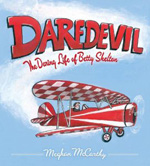 Clearly, Betty Skelton, born in 1926, was ahead of her times in just about every way, but that didn't stop her from dreaming big dreams and reaching, literally, for the sky. Thanks in part to supportive parents, Betty learned to fly a plane in an era when women pilots were rare. She made her first solo flight at 12 and obtained her private pilot's license at 16. When sexism kept her from flying commercially, she turned to stunt flying. Later, after a racecar driving career, she came close to joining the Mercury 7 astronauts in space. Although she didn't accompany them, all her feats during training paved the way for other women astronauts. The text, the acrylic illustrations, and the back matter depict this independent, determined, and free-spirited woman with a great deal of zest, allowing her personality to sparkle on every page. Clearly, Betty thoroughly enjoyed every moment of life’s challenges. Teachers may want to point their more adept student readers to Tanya Lee Stone's Almost Astronauts: 13 Women Who Dared to Dream (Candlewick, 2009) that explains why women were only allowed so far, and no further, in the space program.
Clearly, Betty Skelton, born in 1926, was ahead of her times in just about every way, but that didn't stop her from dreaming big dreams and reaching, literally, for the sky. Thanks in part to supportive parents, Betty learned to fly a plane in an era when women pilots were rare. She made her first solo flight at 12 and obtained her private pilot's license at 16. When sexism kept her from flying commercially, she turned to stunt flying. Later, after a racecar driving career, she came close to joining the Mercury 7 astronauts in space. Although she didn't accompany them, all her feats during training paved the way for other women astronauts. The text, the acrylic illustrations, and the back matter depict this independent, determined, and free-spirited woman with a great deal of zest, allowing her personality to sparkle on every page. Clearly, Betty thoroughly enjoyed every moment of life’s challenges. Teachers may want to point their more adept student readers to Tanya Lee Stone's Almost Astronauts: 13 Women Who Dared to Dream (Candlewick, 2009) that explains why women were only allowed so far, and no further, in the space program.
The author has put together excellent resources that include video, primary sources photos and films of Betty Skelton at her website: http://www.meghan-mccarthy.com/daredevil.html.
- Barbara A. Ward, Washington State University Pullman
Stinson, Kathy. (2013). The man with the violin. Illus. by Dusan Petricic. Postscript by Joshua Bell. Toronto: Annick Press.
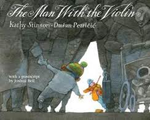 Like everyone else in the subway station, Dylan and his mother were bustling along. When Dylan heard the beautiful strains of music coming from a street musician playing a violin, he wanted to stop and listen. But his mother was in a hurry and rushed him on. When he got home he turned on the radio and listened to the droning of the announcer until the same beautiful violin music that he had heard in the subway station flowed out of the radio. The radio announcer went on to tell his broadcast audience that the famous violinist, Joshua Bell, had conducted an experiment playing his famous and valuable Stradivarius violin in a free concert in the subway station that day and yet only a very few stopped to listen for even a minute. The musician noticed that several children tried to get their parents to stop long enough to hear the captivating violin, but parents were too busy. Based on a true story that Joshua Bell relates at the end of the book, teachers can download two of the songs Joshua played that day in the Washington, D.C. L’Enfant Plaza Metro Station when over a thousand people did not take time to listen to one of the world’s greatest violinists. Annick Press has created an excellent five-minute book trailer with the author giving the back matter of this talented man.
Like everyone else in the subway station, Dylan and his mother were bustling along. When Dylan heard the beautiful strains of music coming from a street musician playing a violin, he wanted to stop and listen. But his mother was in a hurry and rushed him on. When he got home he turned on the radio and listened to the droning of the announcer until the same beautiful violin music that he had heard in the subway station flowed out of the radio. The radio announcer went on to tell his broadcast audience that the famous violinist, Joshua Bell, had conducted an experiment playing his famous and valuable Stradivarius violin in a free concert in the subway station that day and yet only a very few stopped to listen for even a minute. The musician noticed that several children tried to get their parents to stop long enough to hear the captivating violin, but parents were too busy. Based on a true story that Joshua Bell relates at the end of the book, teachers can download two of the songs Joshua played that day in the Washington, D.C. L’Enfant Plaza Metro Station when over a thousand people did not take time to listen to one of the world’s greatest violinists. Annick Press has created an excellent five-minute book trailer with the author giving the back matter of this talented man.
- Karen Hildebrand, Ohio Library and Reading Consultant
Stone, Tanya Lee. (2013). Who says women can’t be doctors? The story of Elizabeth Blackwell. Illus. by Marjorie Priceman. New York: Henry Holt and Co.
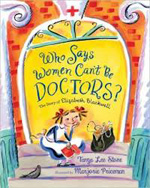 There was a time when women were not allowed to be doctors but a young girl named Elizabeth Blackwell changed that. An adventurous girl who fought with her brother and once slept on the floor without pillow or blanket to toughen herself was encouraged by her father to get a good education. Though she had difficulties, she was finally accepted to Geneva Medical School, only to be sneered at by her fellow male students. Proving to be smarter than most of these colleagues, Elizabeth excelled at medical school. She moved to New York City to begin her practice, but when she opened the doors of her office, no one would enter. Again, she was scoffed at for being a doctor. Discouraged, she took long walks around the city and observed the unhealthy conditions for many people, especially children. She decided to open a free clinic and teach mothers about hygiene and cleanliness for better health practices. Soon more and more women were coming to Elizabeth. Her sister Emily, also a doctor, joined her and their practice grew. A detailed author’s note gives more factual background about Dr. Blackwell including the fact that she eventually opened the Women’s Medical College to help more young women follow their dreams to become doctors. Delightful gouache paintings accompany the life of Elizabeth Blackwell’s life story. Learn more about author Tanya Lee Stone, in this 5 Questions With... interview and her piece entitled "A Nonfiction Author Talks about Common Core Fears" on the Engage blog.
There was a time when women were not allowed to be doctors but a young girl named Elizabeth Blackwell changed that. An adventurous girl who fought with her brother and once slept on the floor without pillow or blanket to toughen herself was encouraged by her father to get a good education. Though she had difficulties, she was finally accepted to Geneva Medical School, only to be sneered at by her fellow male students. Proving to be smarter than most of these colleagues, Elizabeth excelled at medical school. She moved to New York City to begin her practice, but when she opened the doors of her office, no one would enter. Again, she was scoffed at for being a doctor. Discouraged, she took long walks around the city and observed the unhealthy conditions for many people, especially children. She decided to open a free clinic and teach mothers about hygiene and cleanliness for better health practices. Soon more and more women were coming to Elizabeth. Her sister Emily, also a doctor, joined her and their practice grew. A detailed author’s note gives more factual background about Dr. Blackwell including the fact that she eventually opened the Women’s Medical College to help more young women follow their dreams to become doctors. Delightful gouache paintings accompany the life of Elizabeth Blackwell’s life story. Learn more about author Tanya Lee Stone, in this 5 Questions With... interview and her piece entitled "A Nonfiction Author Talks about Common Core Fears" on the Engage blog.
- Karen Hildebrand, Ohio Library and Reading Consultant
GRADES 3-5
Besel, Jennifer M. (2011). Malia and Sasha Obama. Mankato, MN: Capstone Press.
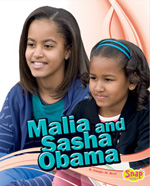 The opening chapter of this book is titled “First Daughters” and includes a color photo of Malia and Sasha on Inauguration Day, January 20, 2009. The book discusses many of the activities the girls are involved in from their own sports to accompanying their parents on the many requirements of being the First Family. Campaigning, helping their father fill packs for military families, or reading all the Harry Potter books with their busy father, the sisters are an integral part of life in the White House. Information about going to school as well as traveling as “America’s Princesses,” this book gives a glimpse into their Presidential lives and living in the limelight.
The opening chapter of this book is titled “First Daughters” and includes a color photo of Malia and Sasha on Inauguration Day, January 20, 2009. The book discusses many of the activities the girls are involved in from their own sports to accompanying their parents on the many requirements of being the First Family. Campaigning, helping their father fill packs for military families, or reading all the Harry Potter books with their busy father, the sisters are an integral part of life in the White House. Information about going to school as well as traveling as “America’s Princesses,” this book gives a glimpse into their Presidential lives and living in the limelight.
- Karen Hildebrand, Ohio Library and Reading Consultant
Heiligman, Deborah. (2013). The boy who loved math: The improbable life of Paul Erdos. Illus. by Le Uyen Pham. New York, NY: Roaring Brook Press.
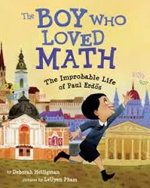 Hungarian Paul Erdos was almost always fascinated with math, thanks to a supportive family that nurtured his keen interest in numbers. His fondness for math, especially prime numbers, never flagged throughout his life and his playful exploration of math led to a lifelong career built on mathematics and ideas about probability. Although his early school days were unpleasant, Erdos eventually found a niche in high school with others who enjoyed math just as much as he did. This biography describes how his obsession with math and perhaps his mother's taking care of all the little details in life for him insured that, brilliant as he was, he had little notion how to perform basic tasks such as doing his laundry or buttering his bread. Readers may find his peripatetic lifestyle exhausting, but they will also be intrigued by this lively story about an intriguing mathematician to whom children were drawn. They will also learn much from author’s notes describing her own interest in Uncle Paul as well as the illustrator’s page-by-page explanations of how she incorporated math within the illustrations on each page. For every probable reason, this picture book biography is highly recommended.
Hungarian Paul Erdos was almost always fascinated with math, thanks to a supportive family that nurtured his keen interest in numbers. His fondness for math, especially prime numbers, never flagged throughout his life and his playful exploration of math led to a lifelong career built on mathematics and ideas about probability. Although his early school days were unpleasant, Erdos eventually found a niche in high school with others who enjoyed math just as much as he did. This biography describes how his obsession with math and perhaps his mother's taking care of all the little details in life for him insured that, brilliant as he was, he had little notion how to perform basic tasks such as doing his laundry or buttering his bread. Readers may find his peripatetic lifestyle exhausting, but they will also be intrigued by this lively story about an intriguing mathematician to whom children were drawn. They will also learn much from author’s notes describing her own interest in Uncle Paul as well as the illustrator’s page-by-page explanations of how she incorporated math within the illustrations on each page. For every probable reason, this picture book biography is highly recommended.
- Barbara A. Ward, Washington State University Pullman
Hill, Laban Carrick. (2013). When the beat was born: DJ Kool Herc and the creation of hip hop. New York: Roaring Brook Press.
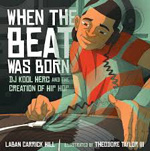 Clive Campbell was born in Jamaica in 1955. He loved listening to all kinds of music, but he especially loved watching the dance parties his local hero King George would throw for everyone in the neighborhood. He knew then that he wanted to be a DJ when he grew up. When he turned thirteen, he moved to the Bronx in New York City. He didn’t like his new neighborhood at first--and that included winters--but then he discovered sports. As his body climbed to 6’5” tall he excelled at sports and earned the nickname "Hercules" and then "Kool Herc." Clive and his family continued their love of music, and he and his sister Cindy invited kids from the neighborhood to dance parties in the rec room of their housing project. As Kool Herc started to play with equipment and turn tables and sounds and microphones, he created a new dance party style they called hip hop. Young people loved this new sound as a new piece of American culture was born, even to the point of halting gang violence to create break dancing and dance moves that defy gravity. Taylor’s larger than life illustrations bring vibrancy to this story, and a timeline of the development of hip hop at the end presents the historic perspective of the creation of this new dance and musical style and how the beat was born.
Clive Campbell was born in Jamaica in 1955. He loved listening to all kinds of music, but he especially loved watching the dance parties his local hero King George would throw for everyone in the neighborhood. He knew then that he wanted to be a DJ when he grew up. When he turned thirteen, he moved to the Bronx in New York City. He didn’t like his new neighborhood at first--and that included winters--but then he discovered sports. As his body climbed to 6’5” tall he excelled at sports and earned the nickname "Hercules" and then "Kool Herc." Clive and his family continued their love of music, and he and his sister Cindy invited kids from the neighborhood to dance parties in the rec room of their housing project. As Kool Herc started to play with equipment and turn tables and sounds and microphones, he created a new dance party style they called hip hop. Young people loved this new sound as a new piece of American culture was born, even to the point of halting gang violence to create break dancing and dance moves that defy gravity. Taylor’s larger than life illustrations bring vibrancy to this story, and a timeline of the development of hip hop at the end presents the historic perspective of the creation of this new dance and musical style and how the beat was born.
- Karen Hildebrand, Ohio Library and Reading Consultant
Morpurgo, Michael. (2013). Meeting Cezanne. Somerville, MA: Candlewick Press.
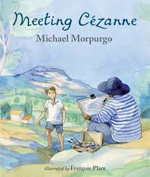 Set in 1960’s beautiful Provence, France, young Yannick is sent to help out his Aunt Mathilde and Uncle Bruno at their inn during his mother’s surgery and convalescence. His older cousin Amandine catches his eye, but she is rather cold and doesn’t seem especially happy that he is there. For the trip, Yannick’s mother has given him a book of the Post-Impressionist artist, Paul Cezanne who grew up in Provence. Yannick is hopeful of meeting the famed artist. One night at the inn, a man leaves a sketch on his napkin in payment for his dinner. Yannick is furious he did not receive money for the dinner and throws the napkin sketch into the fire. Amandine is furious and gives Yannick a hearty tongue-lashing. Little does he know, but attuned readers will observe, the painter who left his payment on a napkin was none other than Pablo Picasso in his famed striped jersey and his bald head, but totally unknown to poor Yannick. Pencil and watercolor paintings give a feel for the art of the time and add to the book’s charm.
Set in 1960’s beautiful Provence, France, young Yannick is sent to help out his Aunt Mathilde and Uncle Bruno at their inn during his mother’s surgery and convalescence. His older cousin Amandine catches his eye, but she is rather cold and doesn’t seem especially happy that he is there. For the trip, Yannick’s mother has given him a book of the Post-Impressionist artist, Paul Cezanne who grew up in Provence. Yannick is hopeful of meeting the famed artist. One night at the inn, a man leaves a sketch on his napkin in payment for his dinner. Yannick is furious he did not receive money for the dinner and throws the napkin sketch into the fire. Amandine is furious and gives Yannick a hearty tongue-lashing. Little does he know, but attuned readers will observe, the painter who left his payment on a napkin was none other than Pablo Picasso in his famed striped jersey and his bald head, but totally unknown to poor Yannick. Pencil and watercolor paintings give a feel for the art of the time and add to the book’s charm.
- Karen Hildebrand, Ohio Library and Reading Consultant
Novesky, Amy. (2013). Mister and Lady Day: Billie Holiday and the dog who loved her. Illus. by Vanessa Brantley Newton. New York, NY: Houghton Mifflin Harcourt.
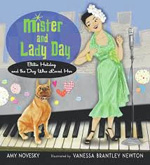 This picture book biography examines the strong bond between jazz singer Billie Holiday and her dogs. Lady Day pampered her pets, even dressing Mister, her boxer, in a mink coat to keep him warm on their nightly strolls through cold city streets. She relied on Mister for support and protection, even while she faced stage fright and rumors about the demise of her career. The text hints at her troubled life while celebrating her musical triumphs and unceasing love for Mister. The memorable gouache and charcoal illustrations perfectly capture the singer’s larger-than-life personality and the times during which Lady Day sang, even including sheet music, the gardenias she wore in her hair, and her stance while singing. Back matter, which includes a photograph of Billie Holiday and Mister, provides additional information about her upbringing and her struggles. An affectionate tribute to a talented artist, the picture book could spark discussion about her arrest for drug possession, her stage fright, and even the bond between humans and animals. Thanks to this book, budding musicians are able to learn a tiny bit about this talented woman even though the book ignores some of the harsher issues of the times.
This picture book biography examines the strong bond between jazz singer Billie Holiday and her dogs. Lady Day pampered her pets, even dressing Mister, her boxer, in a mink coat to keep him warm on their nightly strolls through cold city streets. She relied on Mister for support and protection, even while she faced stage fright and rumors about the demise of her career. The text hints at her troubled life while celebrating her musical triumphs and unceasing love for Mister. The memorable gouache and charcoal illustrations perfectly capture the singer’s larger-than-life personality and the times during which Lady Day sang, even including sheet music, the gardenias she wore in her hair, and her stance while singing. Back matter, which includes a photograph of Billie Holiday and Mister, provides additional information about her upbringing and her struggles. An affectionate tribute to a talented artist, the picture book could spark discussion about her arrest for drug possession, her stage fright, and even the bond between humans and animals. Thanks to this book, budding musicians are able to learn a tiny bit about this talented woman even though the book ignores some of the harsher issues of the times.
- Barbara A. Ward, Washington State University Pullman
Pinkney, Andrea Davis. (2013). Martin & Mahalia: His words, her song. Illus. by Brian Pinkney. New York NY: Little, Brown Books for Young Readers.
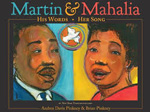 The idea to acknowledge the powerful impact of two unique individuals who raised their voices in different ways in support of the civil rights movement is an interesting one. Juxtaposing the moving words of orator Martin Luther King, Jr., and the melodic tones of singer Mahalia Jackson, this book provides background information about the two while describing their involvement in the fight for freedom during the 1960s and the friendship that seemed to flourish as the result of their shared goals. The author's pitch-perfect prose makes it clear that inspiration and motivation for change come from many sources while the marvelous watercolor and India ink illustrations include snippets from both of their lives. The pairing of the two social justice advocates provides a fresh perspective on the story of this nation’s civil rights struggle. Although many readers may be aware of the importance of oration to inspire the protesters during that particular time period, they may not have realized just how integral music was in rousing and comforting those who marched on.
The idea to acknowledge the powerful impact of two unique individuals who raised their voices in different ways in support of the civil rights movement is an interesting one. Juxtaposing the moving words of orator Martin Luther King, Jr., and the melodic tones of singer Mahalia Jackson, this book provides background information about the two while describing their involvement in the fight for freedom during the 1960s and the friendship that seemed to flourish as the result of their shared goals. The author's pitch-perfect prose makes it clear that inspiration and motivation for change come from many sources while the marvelous watercolor and India ink illustrations include snippets from both of their lives. The pairing of the two social justice advocates provides a fresh perspective on the story of this nation’s civil rights struggle. Although many readers may be aware of the importance of oration to inspire the protesters during that particular time period, they may not have realized just how integral music was in rousing and comforting those who marched on.
- Barbara A. Ward, Washington State University Pullman
Rusch, Elizabeth. (2013). Electrical wizard; how Nikola Tesla lit up the world. Illus. by Oliver Dominguez. New York: Candlewick Press.
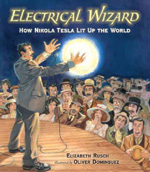 Most youngsters know the name Thomas Edison and associate him with electricity, but few will have heard of Nikola Tesla, his rival in the race to harness electricity to make life easier. While both men were brilliant and innovative, Tesla, who supported the alternating current system, fought an uphill battle against Edison’s support of the direct-current electrical system. The book describes Tesla's early days in Serbia and his public performances to popularize his ideas. Today's world owes him a great debt since much of what we take for granted today, including cell phones, radios, X-rays, even remote control, are based on his ideas. The graphite, gouache, acrylic, and ink illustrations highlight Tesla's showmanship and the power of electricity. Readers will want to read the back matter that explains the science behind his theories as well as providing additional information about the rivalry between these two men. Edison emerges with a few smears of mud on his reputation for some of his actions. For more back story on Tesla, get more information from The Tesla Universe website.
Most youngsters know the name Thomas Edison and associate him with electricity, but few will have heard of Nikola Tesla, his rival in the race to harness electricity to make life easier. While both men were brilliant and innovative, Tesla, who supported the alternating current system, fought an uphill battle against Edison’s support of the direct-current electrical system. The book describes Tesla's early days in Serbia and his public performances to popularize his ideas. Today's world owes him a great debt since much of what we take for granted today, including cell phones, radios, X-rays, even remote control, are based on his ideas. The graphite, gouache, acrylic, and ink illustrations highlight Tesla's showmanship and the power of electricity. Readers will want to read the back matter that explains the science behind his theories as well as providing additional information about the rivalry between these two men. Edison emerges with a few smears of mud on his reputation for some of his actions. For more back story on Tesla, get more information from The Tesla Universe website.
- Barbara A. Ward, Washington State University Pullman
Spilsbury, Richard. (2014). Geronimo. Chicago: Raintree/Capstone.
 The life of the famous Native American is told as part of the Hero Journals series. In chapter one, “I Am Geronimo,” first person accounts of his life as warrior and leader of the Chiricahuas are shared. Archival photographs and illustrations accompany the information. Fact boxes feature quotes, maps, and additional information. Another feature included in a few areas throughout the book is entitled, Document It! These offer suggestions for readers to create projects or activities using the information given in the book. The final chapter, “Geronimo’s Legacy,” offers current information about Native Americans today. A timeline from 1829, the date of Geronimo’s birth, through 1913, when the Chiricahuas leave Fort Sill provide a perspective for the time period.
The life of the famous Native American is told as part of the Hero Journals series. In chapter one, “I Am Geronimo,” first person accounts of his life as warrior and leader of the Chiricahuas are shared. Archival photographs and illustrations accompany the information. Fact boxes feature quotes, maps, and additional information. Another feature included in a few areas throughout the book is entitled, Document It! These offer suggestions for readers to create projects or activities using the information given in the book. The final chapter, “Geronimo’s Legacy,” offers current information about Native Americans today. A timeline from 1829, the date of Geronimo’s birth, through 1913, when the Chiricahuas leave Fort Sill provide a perspective for the time period.
- Karen Hildebrand, Ohio Library and Reading Consultant
GRADES 7-9
Anderson, Tanya. (2013). Tillie Pierce: Teen eyewitness to the Battle of Gettysburg. Minneapolis, MN: Twenty-First Century Books.
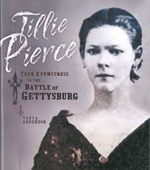 The chances that any student might have heard of the heroic deeds of 15-year old Tillie Pierce are slim. Matilda Pierce was an ordinary teenager until the one of the bloodiest Civil War battles in the United States took place in her neighborhood in Gettysburg. In June 1863, there were rumors of confederate invasion of Gettysburg. On Friday June 26, when Tillie was at school, they heard the rebels had arrived. On July 1, 1863, around 10:00 a.m., Tillie heard the first shots being fired from the gun. Around 1:00 p.m., their neighbor, Hettie Shriver, requested Pierce’s help transporting her and her daughters to her parents' farm three miles away. She was sure that she would be back soon. The battle wore on until July 3, 1863. Tillie and her friends began their humanitarian mission to help the wounded soldiers. Tillie returned to her home around July 7, but the war had changed her forever. The author presents the life of Tillie with great sensitivity and extracts from Tillie’s original book. The pictures of the era and the background are evocative. This is a wonderful book for history classrooms.
The chances that any student might have heard of the heroic deeds of 15-year old Tillie Pierce are slim. Matilda Pierce was an ordinary teenager until the one of the bloodiest Civil War battles in the United States took place in her neighborhood in Gettysburg. In June 1863, there were rumors of confederate invasion of Gettysburg. On Friday June 26, when Tillie was at school, they heard the rebels had arrived. On July 1, 1863, around 10:00 a.m., Tillie heard the first shots being fired from the gun. Around 1:00 p.m., their neighbor, Hettie Shriver, requested Pierce’s help transporting her and her daughters to her parents' farm three miles away. She was sure that she would be back soon. The battle wore on until July 3, 1863. Tillie and her friends began their humanitarian mission to help the wounded soldiers. Tillie returned to her home around July 7, but the war had changed her forever. The author presents the life of Tillie with great sensitivity and extracts from Tillie’s original book. The pictures of the era and the background are evocative. This is a wonderful book for history classrooms.
- Rani Iyer, Washington State University Pullman
Booraem, Hendrik. (2013). Young Jerry Ford; athlete and citizen. Grand Rapids, MI: Eerdmans Books for Young.
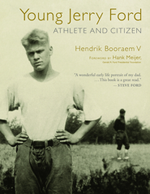 Concentrating on the early years of President Gerald Ford in the 1920s, the author has brought an insightful look into the young man who never imagined or aspired to be President of the United States. Growing up in Grand Rapids, Michigan, Jerry Ford was well-liked, involved in Boy Scouts, was an outstanding athlete and a mediocre student. His mother and stepfather governed the young Ford with strict rules at home but provided a stable home based on their Episcopalian beliefs. Full of details of growing up in this small city in Michigan, readers will get a glimpse of how a young man who was definitely not groomed in politics or a career in that direction, grew up to become the 38th President of the United States.
Concentrating on the early years of President Gerald Ford in the 1920s, the author has brought an insightful look into the young man who never imagined or aspired to be President of the United States. Growing up in Grand Rapids, Michigan, Jerry Ford was well-liked, involved in Boy Scouts, was an outstanding athlete and a mediocre student. His mother and stepfather governed the young Ford with strict rules at home but provided a stable home based on their Episcopalian beliefs. Full of details of growing up in this small city in Michigan, readers will get a glimpse of how a young man who was definitely not groomed in politics or a career in that direction, grew up to become the 38th President of the United States.
- Karen Hildebrand, Ohio Library and Reading Consultant
Schwartz, Heather E. (2013). Girls Rebel! Amazing tales of women who broke the mold. Mankato, MN: Capstone.
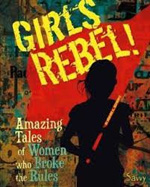 Brief vignettes with photographs alongside them describe the feats of many women through the ages who looked at the way the world operates and decided to take action. Some of the women motivated to change the world that are featured in this book include the expected names such as Rosa Parks, Coretta Scott King, Harriet Tubman, and Gloria Steinem, but the author also profiles female comedians, suffragettes, social activists, artists, and aviators. Most interesting to some young readers, though, may be the inclusion of modern women who have been rebels for a cause, including Julia Butterfly Hill, Asmaa Mahfouz, and Maryam Durani, young females risking their lives for the causes about which they care so deeply. There is a timeline in the back of the book that allows readers to recognize that activism has been the territory of some courageous women for centuries. A good place for young feminists to start reading about others who paved the way for them, the book carefully avoids featuring only women from the United States.
Brief vignettes with photographs alongside them describe the feats of many women through the ages who looked at the way the world operates and decided to take action. Some of the women motivated to change the world that are featured in this book include the expected names such as Rosa Parks, Coretta Scott King, Harriet Tubman, and Gloria Steinem, but the author also profiles female comedians, suffragettes, social activists, artists, and aviators. Most interesting to some young readers, though, may be the inclusion of modern women who have been rebels for a cause, including Julia Butterfly Hill, Asmaa Mahfouz, and Maryam Durani, young females risking their lives for the causes about which they care so deeply. There is a timeline in the back of the book that allows readers to recognize that activism has been the territory of some courageous women for centuries. A good place for young feminists to start reading about others who paved the way for them, the book carefully avoids featuring only women from the United States.
- Barbara A. Ward, Washington State University Pullman
Tougas, Shelley. (2013). Girls rock! Amazing tales of women in music. Mankato, MN: Capstone Press/Savvy.
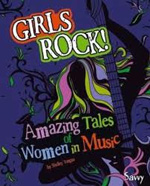 Thumbnail sketches provide information about females who have been involved in the music business in some way. It's cool to have brief biographies documenting the female presence in an industry often dominated by males, but the book’s organization is slightly confusing. Rather than providing stories and photos of the earliest female stars or even stars influenced by certain stars and then moving into stories about present day female musicians, the book seems to jump from one person to another in a rakish fashion, from Janis Joplin to Marian Anderson to Gladys Knight to Lady Gaga. Even Sharon Osbourne is here, featured for her behind-the-scenes management role in the career of her husband heavy metal singer Ozzy Osbourne. Although not all the stories are amazing, young readers with a sense of musical history will be thrilled to have a book so filled with photos and snippets of some of their favorite stars from the past and present.
Thumbnail sketches provide information about females who have been involved in the music business in some way. It's cool to have brief biographies documenting the female presence in an industry often dominated by males, but the book’s organization is slightly confusing. Rather than providing stories and photos of the earliest female stars or even stars influenced by certain stars and then moving into stories about present day female musicians, the book seems to jump from one person to another in a rakish fashion, from Janis Joplin to Marian Anderson to Gladys Knight to Lady Gaga. Even Sharon Osbourne is here, featured for her behind-the-scenes management role in the career of her husband heavy metal singer Ozzy Osbourne. Although not all the stories are amazing, young readers with a sense of musical history will be thrilled to have a book so filled with photos and snippets of some of their favorite stars from the past and present.
- Barbara A. Ward, Washington State University Pullman
GRADES 9-12
Engle, Margarita. (2013). The lightning dreamer: Cuba’s greatest abolitionist. New York: Harcourt. (Fiction)
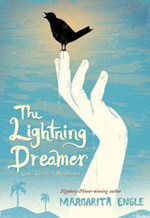 As only Margarita Engle can do, writing in her popular free verse form, this author brings another cultural hero from Cuban history to readers in the United States. Using the voice and life of Gertrudis Gomez de Avellaneda (1814-1873), the author presents thirteen-year-old Tula, as Gertrudis is known, disagreeing with her Mama’s decision to have her enter into a prearranged marriage and settling into a life as wife to a slave owner. Rebelling against this decision as well as the entire concept of slavery, she runs off to the protection of a convent. There, the nuns shelter her, and she discovers the writings of the rebel poet Jose Maria de Heredia. She finds within herself that these words have deep meaning and she begins the yearning to become a writer, too. Her mother and grandfather treat her as if she as lost her mind but through a few relationships she builds at this point in her life, including the family house servant, Ceridad, and her love interest, Sab, a former slave, Tula discovers who she really is. Working as a writer, a feminist and an abolitionist, Engle has loosely based this novel in verse on the life of this brave Cuban woman.
As only Margarita Engle can do, writing in her popular free verse form, this author brings another cultural hero from Cuban history to readers in the United States. Using the voice and life of Gertrudis Gomez de Avellaneda (1814-1873), the author presents thirteen-year-old Tula, as Gertrudis is known, disagreeing with her Mama’s decision to have her enter into a prearranged marriage and settling into a life as wife to a slave owner. Rebelling against this decision as well as the entire concept of slavery, she runs off to the protection of a convent. There, the nuns shelter her, and she discovers the writings of the rebel poet Jose Maria de Heredia. She finds within herself that these words have deep meaning and she begins the yearning to become a writer, too. Her mother and grandfather treat her as if she as lost her mind but through a few relationships she builds at this point in her life, including the family house servant, Ceridad, and her love interest, Sab, a former slave, Tula discovers who she really is. Working as a writer, a feminist and an abolitionist, Engle has loosely based this novel in verse on the life of this brave Cuban woman.
- Karen Hildebrand, Ohio Library and Reading Consultant
Nazario, Sonia. (2013). Enrique’s journey; the true story of a boy determined to reunite with his mother. New York: Delacorte Press.
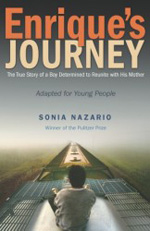 This adapted edition from the author’s 2006 adult book brings the story of a young teen from Honduras through his immigrant journey to the United States to find is mother comes to fruition. His mother left to go to the U.S. to find work and must leave her son behind so she can travel unencumbered because of the many dangers in making her way across the border. Enrique’s mother left when he was a small boy and now at 17, he wants to find her. Mostly traveling on the rooftops of trains, his journey takes four months to cover the 12,000 miles to reunite with his mother. Detailing the dangers from smugglers or gangs and the drug business particularly in Mexico, there are also people who offer kindness, food and water for illegal immigrants knowing they are trying to find family. Nazario is a Pulitzer Prize winning journalist and her journalistic quick style of writing provides the fast pace of Enrique’s narrative. Endnotes provide current information about illegal immigration dangers, statistics and legislation that will offer information for compelling discussions in classrooms today.
This adapted edition from the author’s 2006 adult book brings the story of a young teen from Honduras through his immigrant journey to the United States to find is mother comes to fruition. His mother left to go to the U.S. to find work and must leave her son behind so she can travel unencumbered because of the many dangers in making her way across the border. Enrique’s mother left when he was a small boy and now at 17, he wants to find her. Mostly traveling on the rooftops of trains, his journey takes four months to cover the 12,000 miles to reunite with his mother. Detailing the dangers from smugglers or gangs and the drug business particularly in Mexico, there are also people who offer kindness, food and water for illegal immigrants knowing they are trying to find family. Nazario is a Pulitzer Prize winning journalist and her journalistic quick style of writing provides the fast pace of Enrique’s narrative. Endnotes provide current information about illegal immigration dangers, statistics and legislation that will offer information for compelling discussions in classrooms today.
- Karen Hildebrand, Ohio Library and Reading Consultant
These reviews are submitted by members of the International Reading Association's Children's Literature and Reading Special Interest Group (CL/R SIG) and are published weekly on Reading Today Online. The International Reading Association partners with the National Council of Teachers of English and Verizon Thinkfinity to produce ReadWriteThink.org, a website devoted to providing literacy instruction and interactive resources for grades K–12.